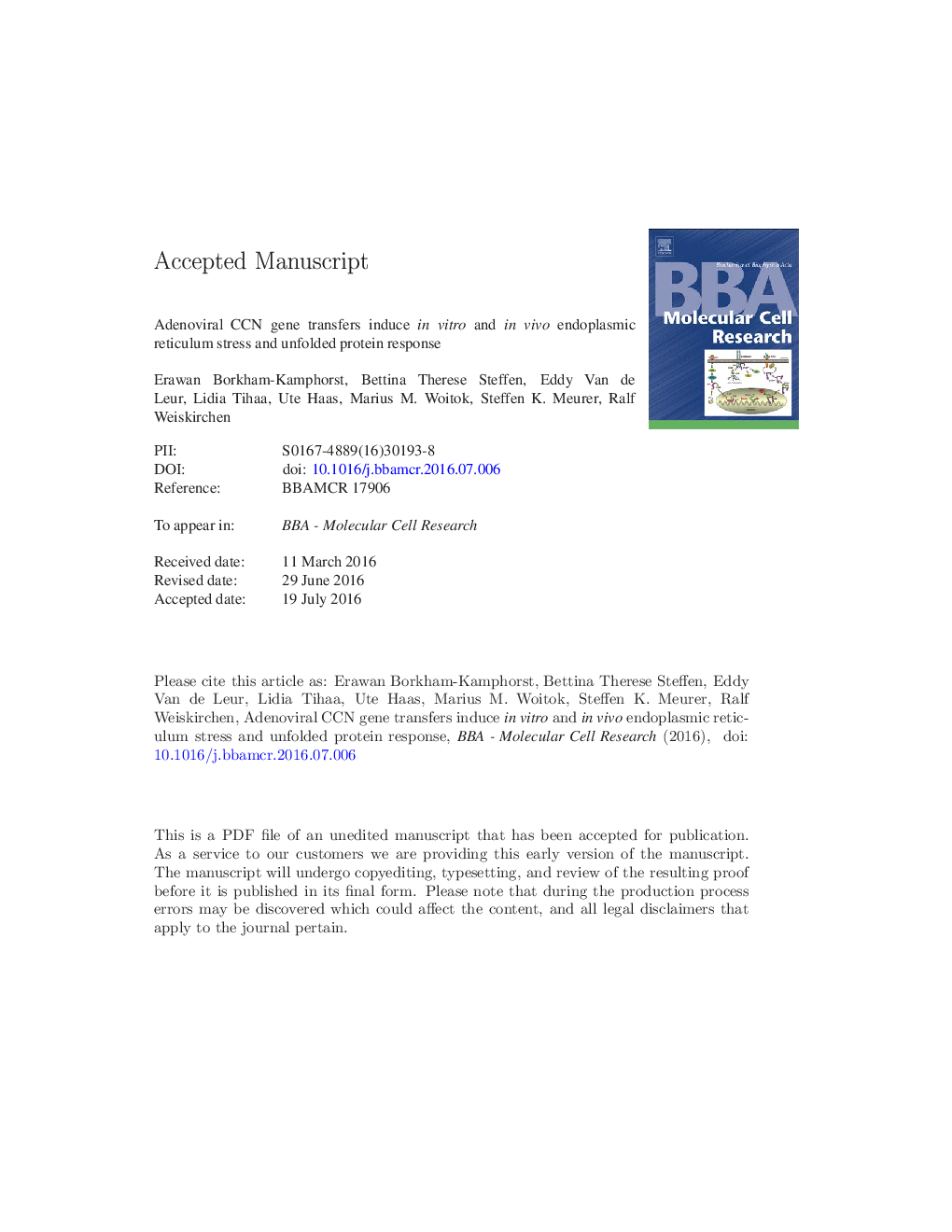| کد مقاله | کد نشریه | سال انتشار | مقاله انگلیسی | نسخه تمام متن |
|---|---|---|---|---|
| 5508688 | 1400395 | 2016 | 30 صفحه PDF | دانلود رایگان |
عنوان انگلیسی مقاله ISI
Adenoviral CCN gene transfers induce in vitro and in vivo endoplasmic reticulum stress and unfolded protein response
دانلود مقاله + سفارش ترجمه
دانلود مقاله ISI انگلیسی
رایگان برای ایرانیان
کلمات کلیدی
ER-associated protein degradationMFBATF6β-galLCN2IRE1BDLPMFERADprotein kinase R (PKR)-like endoplasmic reticulum kinaseHSCECMinositol-requiring enzyme 1 - آنزیم مورد نیاز inositol 1Human - انسانβ-galactosidase - بتا گالاکتوزیدازTUNEL - تونلHepatic stellate cell(s) - سلولهای ستون فقرات کبدیendoplasmic reticulum - شبکه آندوپلاسمی activating transcription factor 6 - فعال کردن عامل رونویسی 6Lipocalin 2 - لیپوکالین 2Extracellular matrix - ماتریکس خارج سلولیRat - موش صحراییPERK - پرکbile duct ligation - پیوند مجرای صفراویmurine - چینی
موضوعات مرتبط
علوم زیستی و بیوفناوری
بیوشیمی، ژنتیک و زیست شناسی مولکولی
زیست شیمی
پیش نمایش صفحه اول مقاله

چکیده انگلیسی
The endoplasmic reticulum (ER) is primarily recognized as the site of synthesis and folding of secreted membrane-bound and certain organelle-targeted proteins. Optimum protein folding requires several factors, including ATP, Ca2Â + and an oxidizing environment to allow disulphide-bond formation. ER is highly sensitive to stress that perturb cellular energy levels, the redox state or the Ca2Â + concentration. Such stresses reduce the protein folding capacity of the ER, resulting in the accumulation and aggregation of unfolded proteins, a condition referred to as unfolded protein response (UPR). Matricellular proteins of the CCN (CYR61, CTGF, NOV) family play essential roles in extracellular matrix signaling and turnover. They exhibit a similar type of organization and share a closely related primary structure, including 38 conserved cysteine residues. Since CCN1/CYR61 overexpression in hepatic stellate cells (HSC) induces ER stress-related apoptosis, we endeavored to investigate whether the adenovirus mediated gene transfer of other members of CCN proteins incurs ER stress in primary HSC and hepatocytes. We found Ad5-CMV-CCN2, Ad5-CMV-CCN3 and Ad5-CMV-CCN4 to induce ER stress and UPR comparable to Ad5-CMV-CCN1. UPR is a pro-survival response to reduce accumulation of unfolded proteins and restore normal ER functioning. If, however protein aggregation is persistent and the stress cannot be resolved, signaling switches from pro-survival to pro-apoptosis. The observed CCN-induced UPR is relevant in wound healing responses and essential for hepatic tissue repair following liver injury. Adenoviral gene transfer induced massive amounts of matricellular proteins proving to effectively mitigate liver fibrosis if targeted cell specific in HSC and myofibroblasts.
ناشر
Database: Elsevier - ScienceDirect (ساینس دایرکت)
Journal: Biochimica et Biophysica Acta (BBA) - Molecular Cell Research - Volume 1863, Issue 11, November 2016, Pages 2604-2612
Journal: Biochimica et Biophysica Acta (BBA) - Molecular Cell Research - Volume 1863, Issue 11, November 2016, Pages 2604-2612
نویسندگان
Erawan Borkham-Kamphorst, Bettina Therese Steffen, Eddy Van de Leur, Lidia Tihaa, Ute Haas, Marius M. Woitok, Steffen K. Meurer, Ralf Weiskirchen,